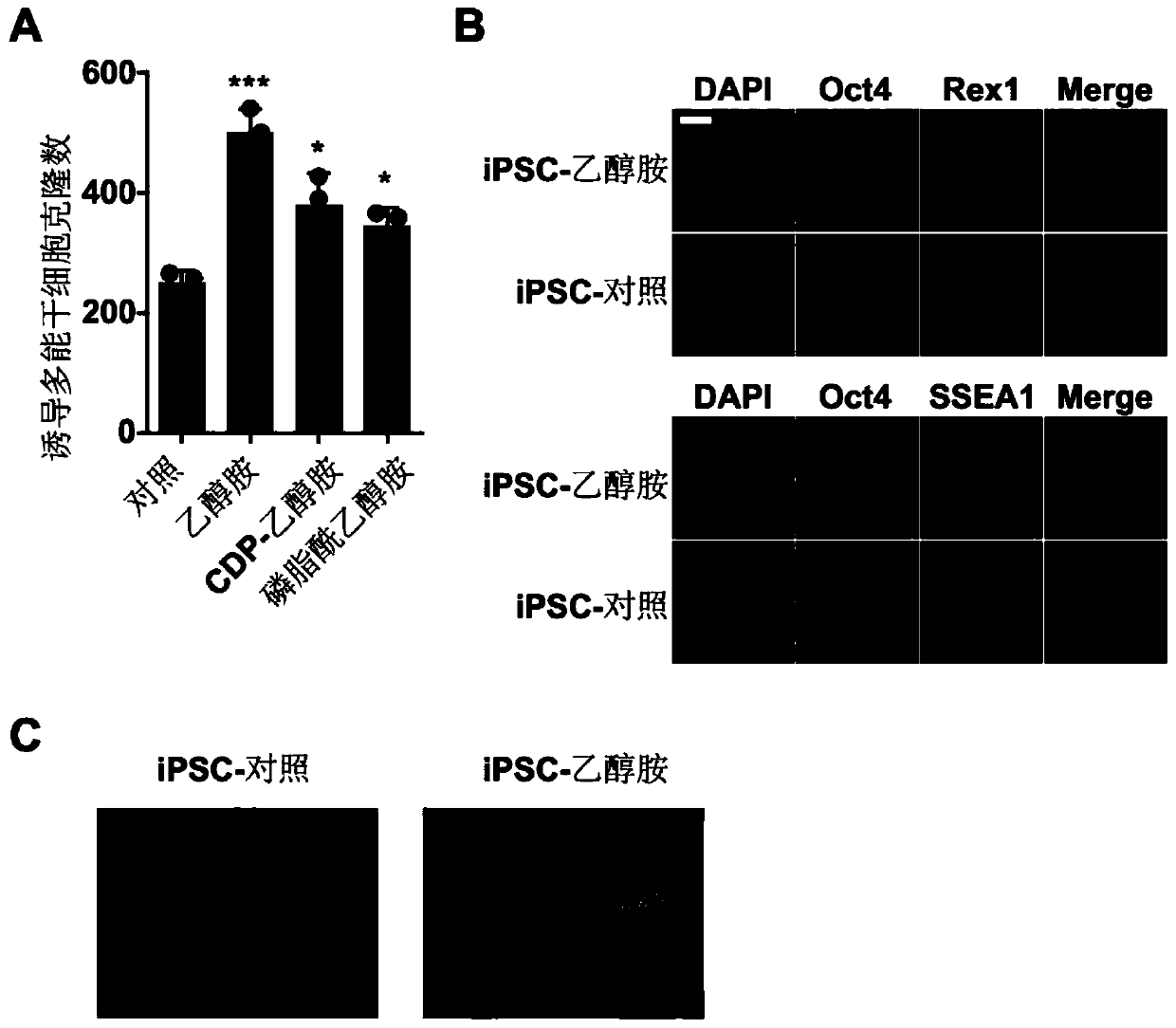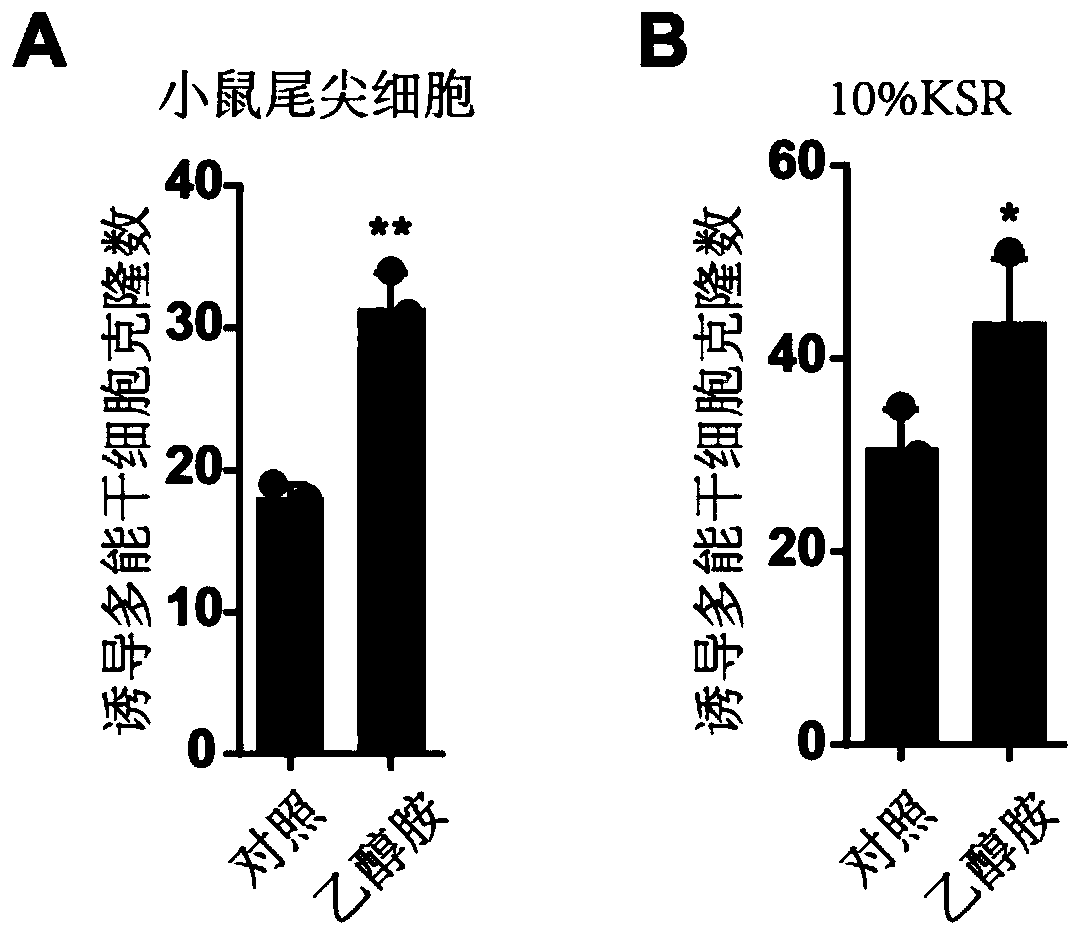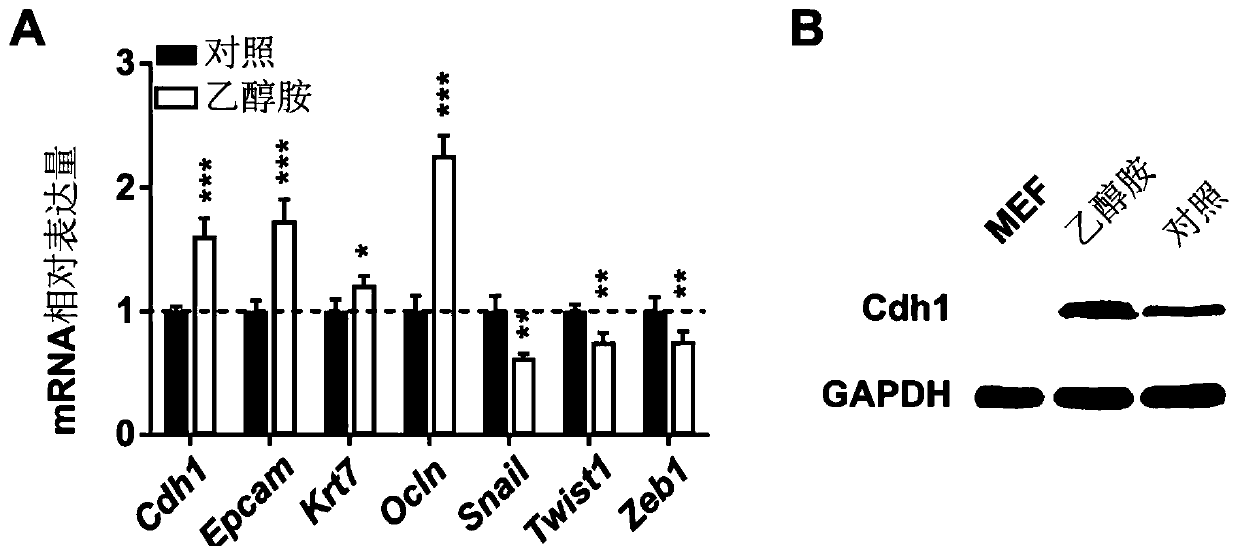Somatic cell reprogramming method and application thereof
A somatic cell reprogramming technology, applied in animal cells, vertebrate cells, cell culture active agents, etc.
- Summary
- Abstract
- Description
- Claims
- Application Information
AI Technical Summary
Problems solved by technology
Method used
Image
Examples
Embodiment 1
[0062]Example 1: Ethanolamine, CDP-ethanolamine, and phosphatidylethanolamine can improve the reprogramming efficiency of mouse fibroblasts
[0063] Such as figure 1 As mentioned, in the basal medium containing DMEM, serum supplement N 2 (Concentration is 1%), growth factor bFGF (concentration is 5ng / ml) and Lif (concentration is 2000units / ml), small molecular compound vitamin C (concentration is 50μg / ml) in the culture medium, add ethanolamine (1mg / ml) respectively ml), CDP-ethanolamine (1mg / ml), and phosphatidylethanolamine (1mg / ml) can improve the reprogramming efficiency of mouse embryonic fibroblasts and greatly increase the number of induced pluripotent stem cell clones ( figure 1 A). The pluripotency of the reprogrammed pluripotent stem cells can be identified by immunofluorescence and chimeric mouse methods. The results of immunofluorescence experiments show that the induced pluripotent stem cells obtained in the control group and ethanolamine group all express the p...
Embodiment 2
[0064] Example 2: Ethanolamine can improve the reprogramming efficiency of mouse tail tip fibroblasts, and can improve the reprogramming efficiency in the basal serum-free medium containing KSR.
[0065] Such as figure 2 As mentioned, in the basal medium containing DMEM, serum supplement N 2 (content is 1%), growth factor bFGF (concentration is 5ng / ml) and Lif (concentration is 2000units / ml), small molecular compound vitamin C (concentration is 50μg / ml) in the culture medium that adds ethanolamine (1mg / ml) After culturing mouse tail tip fibroblasts for 10 days, the reprogramming efficiency of mouse tail tip fibroblasts can be improved, and the number of induced pluripotent stem cell clones can be greatly increased ( figure 2 A). In the basal medium DMEM, serum replacement supplement KSR (15%), growth factors bFGF (5ng / ml) and Lif (2000units / ml), small molecule vitamin C (50μg / ml) Adding ethanolamine (1 mg / ml) to the culture medium of mouse tail tip fibroblasts for 10 days...
Embodiment 3
[0066] Example 3: Ethanolamine can promote the mesenchymal-epithelial transition of mouse embryonic fibroblasts.
[0067] Such as image 3 As mentioned, in the basal medium containing DMEM, serum supplement N 2 (content is 1%), growth factor bFGF (concentration is 5ng / ml) and Lif (concentration is 2000units / ml), small molecular compound vitamin C (concentration is 50μg / ml) in the culture medium that adds ethanolamine (1mg / ml) After culturing mouse embryonic fibroblasts for 2 days, it can promote the mesenchymal epithelial transition of mouse embryonic fibroblasts. Using fluorescent quantitative PCR technology, it was found that ethanolamine promotes the expression of epithelial cell marker genes and reduces the expression of mesenchymal cell marker genes ( image 3 A). Using Western technology to find that ethanolamine can increase the expression of epithelial cell marker proteins in mouse embryonic fibroblasts ( image 3 B).
PUM
 Login to View More
Login to View More Abstract
Description
Claims
Application Information
 Login to View More
Login to View More - R&D
- Intellectual Property
- Life Sciences
- Materials
- Tech Scout
- Unparalleled Data Quality
- Higher Quality Content
- 60% Fewer Hallucinations
Browse by: Latest US Patents, China's latest patents, Technical Efficacy Thesaurus, Application Domain, Technology Topic, Popular Technical Reports.
© 2025 PatSnap. All rights reserved.Legal|Privacy policy|Modern Slavery Act Transparency Statement|Sitemap|About US| Contact US: help@patsnap.com



